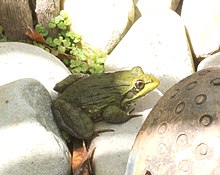
The pickerel frog is a small North American frog, characterized by the appearance of seemingly "hand-drawn" squares on its dorsal surface. Pickerel frogs are the only poisonous frog native to the United States.
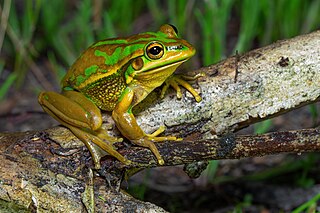
The green and golden bell frog, also named the green bell frog, green and golden swamp frog and green frog, is a species of ground-dwelling tree frog native to eastern Australia. Despite its classification and climbing abilities, it does not live in trees and spends almost all of its time close to ground level. It can reach up to 11 cm (4.5 in) in length, making it one of Australia's largest frogs.
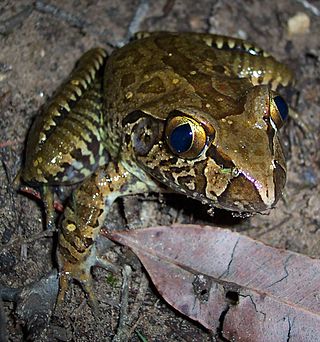
The giant barred frog is a species of barred frog found in Australia. It occurs from south-eastern Queensland to just south of the Newcastle region in New South Wales. It is associated with flowing streams and creeks in wet sclerophyll and rainforest habitats from the coast to the ranges.

The dainty green tree frog, also known as the graceful tree frog, is a species of tree frog in the subfamily Pelodryadinae. It is native to eastern Queensland, and north-eastern New South Wales, Australia and ranges from northern Cape York in Queensland to Gosford in New South Wales, with a small and most likely introduced population in Hornsby Heights in Sydney. It is one of two faunal emblems of the City of Brisbane.

The Booroolong frog is a species of stream-dwelling frog native to the Great Dividing Range in New South Wales, Australia. It is a member of the Hylidae, or the "tree frog" family. The Booroolong frog is classified by the IUCN as a Critically Endangered Species.
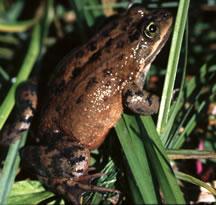
The Oregon spotted frog is a member of the frog family Ranidae of order Anura. It is a medium-sized aquatic frog endemic to the Pacific Northwest and historically well distributed in the Puget Trough/Willamette Valley province and the Cascade Mountains of south-central Washington and Oregon. It is relatively rare within its range and is listed globally as vulnerable.
Nyctimystes kubori is a species of frog in the subfamily Pelodryadinae of the family Hylidae. It is endemic to Papua New Guinea and is widespread in the New Guinea Highlands between 141°E and 147°E and in the mountains of the Huon Peninsula. The specific name kubori refers to its type locality in the Kubor Mountains. Common name sandy big-eyed treefrog has been coined for this species.
Sarcohyla sabrina, also known as the Sierra Juarez treefrog, is a species of frog in the family Hylidae. It is endemic to the northern slopes of Sierra de Juárez in northern Oaxaca, Mexico. The specific name sabrina is Latin for river nymph and refers to the close association of this species with streams.
Quilticohyla acrochorda, commonly known as the warty mountain stream frog, is a species of frogs in the family Hylidae. It is endemic to Mexico and known from the Atlantic slopes of the Sierra Juárez in Oaxaca. Before being described as a new species in 2000, it was mixed with Ptychohyla erythromma. The specific name acrochorda is a Greek word for "wart" and refers to the distinctive white warts on the posterior surface of the thigh of this frog.
Atlantihyla panchoi, also known as the Guatemala stream frog, is a species of frog in the family Hylidae. It is endemic to eastern Guatemala and is only known from three localities in the Sierra de las Minas and Montañas del Mico ranges. The specific name panchoi honors Laurence Cooper "Don Pancho" Stuart, an American herpetologist.

Ptychohyla zophodes is a species of frogs in the family Hylidae. It is endemic to Mexico and known from the Atlantic slopes of the Sierra Madre de Oaxaca in northern Oaxaca and adjacent central-western Veracruz. Before being described as a new species in 2000, it was mixed with Ptychohyla leonhardschultzei. The specific name zophodes is a Greek word meaning "dusky" or "gloomy" and refers to the distinctive dark coloration of the species as well as its cloud forest habitat. Common name gloomy mountain stream frog has been coined for it.
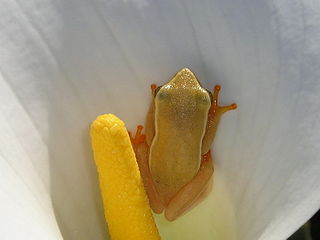
The arum lily reed frog, Horstock's arum-frog, arum lily frog, or Horstock's reed frog is a species of frog in the family Hyperoliidae. It is endemic to South Africa.

Amietia delalandii, also known as the Delalande's river frog, the Drakensberg frog, Drakensberg river frog, or Sani Pass frog, is a species of southern African river frog in the family Pyxicephalidae. It is found in Lesotho, South Africa, Mozambique, Malawi, Zimbabwe, and possibly Zambia. It is the sister species to A. vertebralis.
Amietia ruwenzorica is a species of frog in the family Pyxicephalidae. It is found in the eastern Democratic Republic of the Congo and western Uganda, including the eponymous Rwenzori Mountains on the Uganda/DRC border as well as Kabobo Plateau and Itombwe Mountains in DRC.
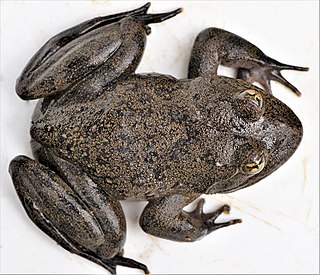
Amietia vertebralis, also known as Maluti river frog, aquatic river frog, ice frog, large-mouthed frog, or water frog, is a species of frogs in the family Pyxicephalidae. It is an aquatic high-altitude species found in Lesotho and neighbouring South Africa.
Meristogenys poecilus is a species of frog in the family Ranidae. It is endemic to Borneo and known from between central Sarawak (Malaysia) and central Kalimantan (Indonesia). The specific name poecilus is derived from the Greek poikolos, meaning "pied" or "blotched", in reference to diagnostic pattern on rear of the thigh. Common name Malaysian Borneo frog has been coined for this species.
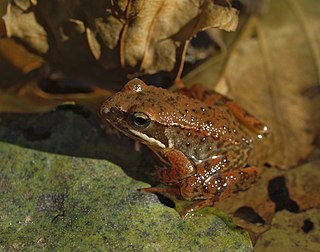
The Iberian frog, also known as Iberian stream frog, is a species of frog in the family Ranidae found in Portugal and Spain. Its natural habitats are rivers, mountain streams and swamps. It is threatened by habitat loss, introduced species, climate change, water contamination, and increased ultraviolet radiation.
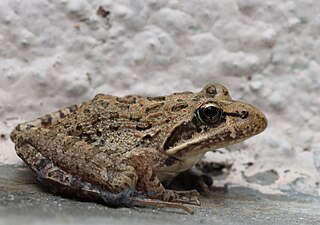
Gray's stream frog is a fairly small species of frog in the family Pyxicephalidae. It is a ground dweller, living mainly in vegetation such as sedges, generally brown, slenderly built and agile, with long, practically unwebbed toes.
Amietia hymenopus is a species of frog in the family Pyxicephalidae. It is found in the Drakensberg Mountains and Lesotho Highlands in northeastern Lesotho and adjacent South Africa. This species has many common names: Phofung river frog, Berg stream frog, Drakensberg river frog, Natal Drakensberg frog, Drakensberg frog, and Drakensberg rana.

Amietia desaegeri is a species of frog in the family Pyxicephalidae. It is found west and south of the Rwenzori Mountains in eastern Democratic Republic of the Congo and north-western Rwanda. The common names Byangolo frog and De Saeger's river frog have been coined for it.


